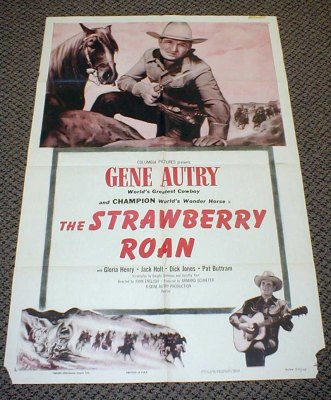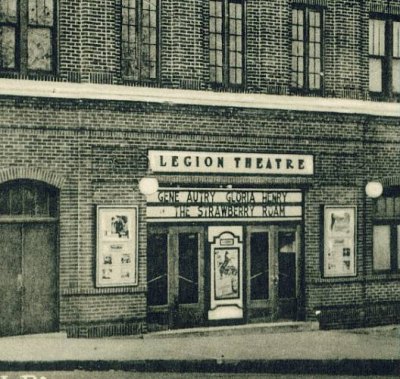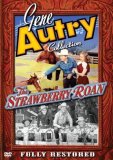| Reviews & Columns |
|
Reviews DVD TV on DVD Blu-ray 4K UHD International DVDs In Theaters Reviews by Studio Video Games Features Collector Series DVDs Easter Egg Database Interviews DVD Talk Radio Feature Articles Columns Anime Talk DVD Savant Horror DVDs The M.O.D. Squad Art House HD Talk Silent DVD
|
DVD Talk Forum |
|
|
| Resources |
|
DVD Price Search Customer Service #'s RCE Info Links |
|
Columns
|
|
|
Gene Autry: The Strawberry Roan
Ranch foreman Gene Autry (Gene Autry) and his pals capture a wild strawberry roan for Joe (Dickie Jones), the 20-year-old son of ranch owner Walt Bailey (Jack Holt). Joe is eager to break the horse himself, but is thrown and trampled by the wild animal, suffering a severe spinal injury. In his rage Walt wants to shoot the horse then and there, but an outraged Gene sets the animal free. Pursued by a relentless Walt, the horse eventually falls down a ravine but survives, though Gene pretends to shoot the animal to buy it some time so that it can recover from its injuries.
Doctors are cautiously optimistic that Joe might walk again, but the boy falls into a deep depression, no doubt taunted by the skis and snowshoes that decorate his room (a nice bit of understated set decoration here). Meanwhile, Walt learns that the strawberry roan is still alive and as he regards the wild horse as his personal property (as it was first captured on his land), brands Gene an horse thief, offering a $1,000 reward for his capture.
Though modest in its aims, The Strawberry Roan is sentimental in the good sense of the word, a pleasant little film not limited to B-Western fans, as it makes strong entertainment for "the whole family," as it were. It's a good film for parents with young children. There's little doubt all will be right with the world in the end, but the picture does offer its share of surprises. (Major Spoilers) At the climax Gene, still on the run has coaxed Joe, at last able to move his legs, on his strawberry roan, and horse and boy ride across the prairie. In the distance, however, Joe's father mistakes his euphoric son for a fleeing Gene, and madly starts shooting at the animal and in a genuinely shocking bit of irony ends up shooting his own son. (The boy survives, thankfully.)
The picture was shot in a low-cost alternative to expensive 3-strip Technicolor, a two-color subtractive process called Cinecolor, which was popular in lower-budgeted features from about 1945-1953. Unlike Technicolor, Cinecolor was only about 20% more expensive to use than standard black and white film and its limited color palette, which produced strong reds, oranges, blues, browns, and flesh tones but weak greens and purples, was well-suited to outdoor Westerns. The Strawberry Roan was partly shot on location in Arizona, and the scenery is quite beautiful though quite a bit of the film, including all the business with Gene nursing the title horse back to health at the bottom of the ravine, was done on cramped and phony soundstage "exteriors" that match the location footage not at all.
Ingénue Gloria Henry (TV's Dennis the Menace) has hardly anything to do, but both Jack Holt and Dick Jones are very good in their roles. Pat Buttram, soon to be Gene's sidekick on the latter's TV series, makes his film debut here.
Video & Audio
The Strawberry Roan is presented in full frame format, in what appears to be a composite of elements in varying condition. The image is sharp throughout, and while the color is frequently misaligned, there's been a lot of obvious effort to make the image as good as possible, and many scenes look awfully good, Cinecolor at its best. The English Dolby Digital mono is also clean and free from damage or distortion, though there are no subtitle options.
Extra Features
Supplements abound once again, more than ever before. New to this series (as far as this reviewer can recall) is an audio commentary, with Gene's co-stars Gloria Henry and Dick Jones. Gene Autry Entertainment Vice President Karla Buhlman does a fine job moderating the relaxed discussion, which is both warmly nostalgic and informative.
Another nice extra is a 1958 unsold pilot running 26 minutes, The Strawberry Roan, in fact a retooling of the 11th episode of Gene's 1955 show The Adventures of Champion. Boyd Magers provides a text introduction that puts the project into perspective though it's not clear the series, had it sold, would have simply re-edited and redubbed existing Champion shows or whether new episodes would have been put into production. In any case this fascinating reworking has been sitting in a vault somewhere for nearly half a century and ties in with the feature presentation quite nicely.
Also included is the usual Reminiscing with Gene Autry and Pat Buttram at the Melody Ranch Theater (a brief six minutes this time), excerpts from a 1987 Nashville Network series with Gene and Pat providing anecdotal wraparound bits that accompanied The Strawberry Roan's airings on that channel. They briefly touch on co-star Jack Holt, the training of Champion, and the Sedona, Arizona location. A reissue trailer, printed in black and white and billed as "A Parade Pictures Reprint" is also included.
Don't Touch That Dial! Gene Autry is On the Air is a September 19, 1948 episode of radio's "The Gene Autry Show," and runs about 30 minutes
The Production and Publicity Stills, Poster Art and Lobby Cards, Original Press Kit, and Daily Production Reports are crammed with great archival material, while low-budget producer and die-hard Gene Autry fan Alex Gordon provides Trivia and Movie Facts about the film.
In honor of Gene Autry's 100th birthday, additional extra features include Chapter Seven of the bizarre but very entertaining 1935 Mascot serial The Phantom Empire, Gene's first starring role. (Each new Autry release this year will include one chapter.)
Parting Thoughts
The Strawberry Roan represents another stellar release from Image and Gene Autry Entertainment. Though Gene Autry's B-Westerns don't get anything like the kind of attention on DVD discussion boards the restorations and supplement-crammed packaging nonetheless is among the finest work being done in the format, and this film's wide appeal as general family entertainment make it especially appealing. Highly Recommended.
Film historian Stuart Galbraith IV's most recent essays appear in Criterion's new three-disc Seven Samurai DVD and BCI Eclipse's The Quiet Duel.
|
| Popular Reviews |
| Sponsored Links |
|
|
| Sponsored Links |
|
|
| Release List | Reviews | Shop | Newsletter | Forum | DVD Giveaways | Blu-Ray | Advertise |
|
Copyright 2024 DVDTalk.com All Rights Reserved. Legal Info, Privacy Policy, Terms of Use,
Manage Preferences,
Your Privacy Choices | |||||||
















